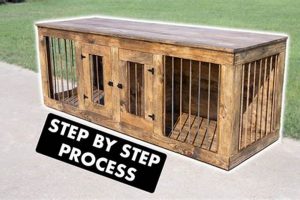The construction of customized assistive devices for canines, specifically designed to aid in accessing elevated surfaces, encompasses a range of approaches. These projects involve varying levels of complexity and utilize diverse materials, all centered on providing a safe and supportive means for pets to overcome physical limitations or environmental obstacles, such as entering vehicles or reaching furniture. This type of project often emphasizes cost-effectiveness and personalization to suit individual pet needs and owner preferences.
Providing accessible routes for dogs offers multiple advantages, promoting physical well-being by reducing strain on joints and preventing potential injuries. Historically, such aids were less common, with pet owners relying on lifting or other less ergonomic methods. However, increased awareness of canine health and accessibility needs has led to the popularization of customized solutions that can extend a dog’s active lifespan and improve their quality of life, particularly for aging or mobility-impaired animals.
The subsequent discussion will delve into essential considerations for undertaking such a project, including material selection, design principles, and safety protocols to ensure the final product is both functional and secure for its intended user.
Essential Considerations for Canine Access Structure Construction
The following guidelines provide fundamental advice for building a stable and safe structure to assist canines in reaching elevated areas.
Tip 1: Material Selection: Prioritize durable and weather-resistant materials such as treated lumber or composite decking. These withstand wear and outdoor exposure, ensuring longevity and structural integrity. For indoor ramps, consider hardwoods with a non-toxic sealant.
Tip 2: Slope Gradient: Calculate the optimal incline based on the dog’s size, age, and physical condition. A shallower slope is generally preferable, particularly for smaller breeds or dogs with joint issues. A gradient no steeper than 25 degrees is recommended for most cases.
Tip 3: Surface Traction: Implement a non-slip surface to prevent slippage and potential injuries. Options include carpet, rubber mats, or textured paint. Ensure the chosen material provides adequate grip in both wet and dry conditions.
Tip 4: Structural Stability: Reinforce the frame with screws and bracing to prevent wobbling or collapse. Regularly inspect joints and connections for signs of wear or loosening. A well-constructed frame is crucial for supporting the dog’s weight and maintaining stability.
Tip 5: Safety Barriers: Incorporate side rails or barriers along the ramp’s edges to prevent accidental falls. The height of the barriers should be sufficient to contain the dog’s movement without causing obstruction or anxiety.
Tip 6: Weight Capacity: Account for the dog’s weight and any additional stress loads. Over-engineering the structure ensures it can safely accommodate the intended user without risk of failure. Consider the maximum weight the ramp will need to support.
Tip 7: Gradual Introduction: Familiarize the dog with the ramp gradually using positive reinforcement techniques. Begin by rewarding the dog for approaching the ramp, then progress to walking on it with treats and praise. Patience is key to ensuring a comfortable and confident transition.
Tip 8: Regular Maintenance: Conduct periodic inspections to identify and address any potential hazards. Tighten loose screws, repair damaged surfaces, and replace worn components promptly. Proactive maintenance preserves the ramp’s safety and functionality.
Adhering to these guidelines promotes the creation of a secure and effective assistive device, enhancing the dog’s accessibility and overall well-being.
The following sections will address design considerations and provide step-by-step construction instructions.
1. Stable structural design
Stable structural design is paramount in the context of canine access ramp construction. It directly influences the safety, longevity, and usability of the finished product. A poorly designed or executed structure can compromise the ramp’s integrity, posing a risk of injury to the animal.
- Load-Bearing Capacity
The load-bearing capacity of the structure dictates the maximum weight it can safely support. This must exceed the dog’s weight, with a safety margin to account for dynamic loads (e.g., jumping or sudden movements). Failure to adequately calculate and reinforce the structure can lead to collapse under weight, potentially injuring the animal.
- Joint Integrity
The strength and stability of joints (where different structural elements connect) are critical. Weak or improperly fastened joints can lead to wobbling, instability, and eventual failure. Screws, bolts, and adhesives should be appropriately sized and applied to ensure secure connections that can withstand repeated use and stress.
- Material Rigidity
The inherent rigidity of the materials used in construction contributes to overall stability. Flexible or easily deformable materials may cause the ramp to sag or bend under load, creating an uneven or unstable surface. Choosing materials with sufficient stiffness and resistance to deformation is essential for maintaining a consistent and safe walking surface.
- Support Distribution
The placement and density of supports beneath the ramp surface significantly impact its structural integrity. Insufficient or unevenly distributed supports can lead to localized stress concentrations and potential failure points. Adequate and evenly spaced supports are necessary to distribute the load across the entire structure, minimizing stress and preventing warping or breakage.
Therefore, a robust and well-engineered structural design is not merely an aesthetic consideration, but a fundamental requirement for any canine access structure. It directly translates to the safety and functionality of the ramp, ensuring that it provides a reliable and secure means of access for the animal. Neglecting these principles can result in a potentially dangerous and unusable product.
2. Appropriate ramp inclination
The gradient of a canine access structure represents a critical design parameter impacting both the usability and safety of the device. Within the context of constructing such aids, careful consideration of the inclination angle is paramount to accommodating the physical capabilities of the intended user.
- Impact on Joint Stress
Steeper inclines increase the force required to ascend, placing undue stress on the dog’s joints, particularly in the hips, knees, and spine. This is especially relevant for older dogs, those with arthritis or other mobility impairments, or breeds predisposed to joint problems. A shallower incline reduces joint stress, making the ramp easier and more comfortable to use, potentially extending the dog’s active lifespan.
- Influence on Muscular Exertion
A steeper gradient necessitates greater muscular exertion for propulsion and balance maintenance. This increased effort can lead to fatigue, particularly for smaller breeds or dogs with reduced muscle mass. A more gradual incline minimizes the required muscular force, promoting easier ascent and reducing the risk of overexertion or muscle strain.
- Effect on Stability and Balance
Increased inclines reduce the dog’s stability and require greater balancing efforts. This can be particularly challenging for dogs with neurological conditions or those prone to dizziness. A shallower gradient enhances stability, making it easier for the dog to maintain balance and reducing the risk of slips or falls. Side rails can further mitigate the risk of instability.
- Consideration of Breed-Specific Needs
Different breeds possess varying physical characteristics and predispositions to specific health issues. For example, chondrodystrophic breeds (e.g., Dachshunds, Corgis) with long backs and short legs are particularly vulnerable to spinal problems and require very gradual inclines. Tailoring the ramp angle to the specific needs and limitations of the dog’s breed is essential for ensuring optimal comfort and safety.
Therefore, the selection of an appropriate ramp gradient within a ‘dog ramp diy’ project necessitates a thorough assessment of the individual dog’s physical capabilities, health status, and breed-specific considerations. Implementing an incline that minimizes joint stress, muscular exertion, and stability challenges contributes directly to a safer and more functional mobility aid.
3. Secure surface traction
The concept of secure surface traction is intrinsically linked to the successful execution and safe utilization of a DIY canine access structure. The selection and implementation of appropriate surface materials directly affect a dog’s ability to confidently and securely navigate the ramp. Without adequate traction, even a well-designed and structurally sound ramp becomes a potential hazard, leading to slips, falls, and subsequent injuries. The cause-and-effect relationship is clear: insufficient grip results in instability, which directly increases the risk of trauma for the animal. The significance of this component in the project cannot be overstated; it forms a primary safety element, comparable in importance to structural integrity.
Several real-life examples highlight the consequences of neglecting surface traction. A ramp constructed with smooth, varnished wood, while aesthetically pleasing, offers minimal grip, especially when wet. Similarly, ramps covered with loose carpeting can create tripping hazards. Conversely, ramps incorporating materials like textured rubber, durable outdoor carpeting, or paint with a non-slip additive demonstrate the practical application of prioritizing traction. These materials provide a stable and reliable walking surface, promoting confident and safe use. Understanding the mechanical principles of friction and grip, and applying this knowledge to material selection, is critical for ensuring that the DIY ramp is both functional and secure.
In conclusion, secure surface traction is not merely a desirable feature, but a fundamental requirement for a safe and effective canine access ramp. The selection of appropriate materials, coupled with mindful construction techniques, directly influences the dog’s ability to use the ramp without risk of injury. Challenges in achieving optimal traction may arise from cost constraints or aesthetic considerations, however, prioritizing safety should always supersede these concerns. By integrating secure surface traction into the design and construction phases, the outcome becomes a beneficial assistive device, enhancing the animal’s mobility and overall well-being.
4. Durable material selection
Within the domain of canine access structure fabrication, the selection of robust and resilient materials constitutes a foundational element, directly influencing the lifespan, safety, and overall utility of the finished product. This consideration transcends mere cost-effectiveness, demanding a comprehensive understanding of material properties and their suitability for the intended application.
- Resistance to Environmental Degradation
Materials employed in exterior canine access structures must exhibit a high degree of resistance to environmental factors such as moisture, ultraviolet radiation, and temperature fluctuations. Untreated wood, for instance, is susceptible to rot and decay, compromising structural integrity. Conversely, pressure-treated lumber, composite decking, or specific types of plastic offer enhanced durability and resistance to these degrading elements, prolonging the structure’s lifespan and minimizing maintenance requirements.
- Load-Bearing Capacity and Structural Integrity
The chosen materials must possess adequate load-bearing capacity to safely support the weight of the canine user, accounting for dynamic loads associated with movement. Inferior materials may exhibit excessive flex or outright failure under stress, creating a hazardous situation. Steel, reinforced polymers, and high-density hardwoods provide superior structural integrity and are thus suitable choices for constructing load-bearing components.
- Resistance to Wear and Abrasion
The walking surface of the access structure experiences continuous wear and abrasion from the dog’s paws. Materials prone to rapid wear, such as thin carpeting or softwoods, require frequent replacement, increasing long-term costs and potentially compromising safety. Durable materials such as textured rubber, outdoor-grade carpeting, or hardwoods with a resilient finish offer increased resistance to wear and maintain a secure footing for the animal.
- Chemical Inertness and Non-Toxicity
Materials utilized in the construction process should be chemically inert and non-toxic to prevent potential harm to the animal. Certain paints, adhesives, or treated woods may release harmful chemicals that can be ingested or absorbed through the skin. Selecting materials with low VOC (volatile organic compound) emissions and ensuring that all treated surfaces are properly sealed minimizes the risk of chemical exposure.
The integration of durable material selection into a ‘dog ramp diy’ initiative serves to enhance the longevity, safety, and overall value of the finished product. By carefully evaluating material properties and matching them to the specific requirements of the application, constructors can create a reliable and lasting assistive device for their canine companions.
5. Consistent safety enforcement
Consistent adherence to safety protocols during and after the construction of canine access structures is not merely advisable but a fundamental prerequisite for ensuring the well-being of the animal using the device. The design and construction phases represent critical opportunities to integrate safety features, but sustained vigilance in monitoring and maintaining these features is equally important for preventing accidents and injuries.
- Regular Inspection and Maintenance
Periodic examination of the structure for signs of wear, damage, or instability is essential. Loose fasteners, splintered wood, or worn traction surfaces can create hazards that compromise the ramp’s safety. Proactive maintenance, including tightening screws, repairing damaged areas, and replacing worn components, mitigates the risk of accidents and ensures the continued integrity of the access device. Neglecting routine inspections can lead to gradual deterioration and eventual failure of critical safety features.
- Supervision and Guidance During Initial Use
Introducing the dog to the newly constructed ramp requires patience and supervision. Guiding the animal and providing positive reinforcement helps build confidence and ensures proper usage techniques are learned. Allowing unsupervised access before the dog is comfortable and proficient can lead to anxiety, missteps, and potential injuries. Initial supervised sessions allow for correction of improper gait or technique and reinforce safe practices.
- Environmental Hazard Mitigation
The surrounding environment of the canine access structure must be assessed and modified to minimize potential hazards. Obstructions near the ramp’s entrance or exit, slippery surfaces adjacent to the structure, or exposure to extreme weather conditions can all increase the risk of accidents. Clearing obstacles, applying non-slip coatings to surrounding surfaces, and providing shelter from inclement weather contribute to a safer overall environment for ramp usage.
- Weight Limit Adherence and Usage Guidelines
The designed weight capacity of the ramp must be strictly adhered to. Overloading the structure can compromise its stability and lead to collapse. Furthermore, clear usage guidelines, such as prohibiting children from playing on the ramp or limiting its use to specific animals, should be established and enforced. Overlooking these guidelines can result in structural damage and potential injuries to both animals and humans.
The successful implementation of a “dog ramp diy” project hinges not only on the quality of construction but also on the consistent enforcement of safety protocols. These measures, encompassing regular inspection, supervised initial usage, environmental hazard mitigation, and adherence to weight limits, collectively contribute to a safer and more functional assistive device for the canine user.
Frequently Asked Questions
The following questions address common concerns and misconceptions regarding the design, construction, and implementation of canine access structures. The information presented aims to provide clarity and promote safe and effective practices.
Question 1: What constitutes a safe incline for a canine access structure?
The optimal incline depends on the dog’s size, age, breed, and physical condition. A general guideline is to maintain a gradient no steeper than 25 degrees. Shallower inclines are preferable for smaller breeds, older dogs, or those with joint issues. Consultation with a veterinarian is advisable to determine the most appropriate angle for individual circumstances.
Question 2: Which materials are recommended for constructing a durable and weather-resistant ramp?
For outdoor applications, pressure-treated lumber or composite decking offer resistance to moisture and decay. Indoor ramps can be constructed from hardwoods with a non-toxic sealant. The selection of materials should prioritize structural integrity, resistance to environmental degradation, and non-toxicity to ensure longevity and safety.
Question 3: How can surface traction be enhanced to prevent slips and falls?
The application of non-slip materials such as textured rubber, outdoor carpeting, or paint with a non-slip additive significantly improves traction. Ensure the chosen material provides adequate grip in both wet and dry conditions. Regular inspection and replacement of worn traction surfaces are essential for maintaining safety.
Question 4: What safety features should be incorporated into the design of a canine access structure?
Side rails or barriers along the ramp’s edges prevent accidental falls and are crucial for ensuring the dog’s safety. The height of the barriers should be sufficient to contain the dog’s movement without causing obstruction or anxiety. A stable and well-reinforced frame is also essential for preventing wobbling or collapse.
Question 5: How can a dog be introduced to a new access structure to encourage confident use?
A gradual introduction using positive reinforcement techniques is recommended. Begin by rewarding the dog for approaching the ramp, then progress to walking on it with treats and praise. Patience and consistency are key to ensuring a comfortable and confident transition. Avoid forcing the dog onto the ramp or creating a stressful environment.
Question 6: How often should a canine access structure be inspected and maintained?
Regular inspections should be conducted at least monthly, or more frequently in high-use environments. Check for loose screws, splintered wood, worn traction surfaces, or any other signs of damage. Promptly address any identified issues to maintain the structure’s safety and functionality.
These FAQs provide essential insights for those considering a DIY approach to canine access solutions. Understanding these principles ensures the creation of a safe, effective, and beneficial assistive device.
The subsequent section will explore advanced design concepts and customization options.
Concluding Remarks on Canine Access Structure Construction
The preceding discussion has explored essential considerations for constructing canine access structures. Attention has been given to material selection, structural stability, surface traction, and gradient optimization to produce safe and effective assistive devices. These points emphasize the need for careful planning and execution to address the specific needs of the animal using the ramp.
The construction of a stable, accessible ramp necessitates adherence to established safety principles and a commitment to ongoing maintenance. With meticulous attention to detail and a focus on the animal’s well-being, such projects can significantly enhance the quality of life for canines experiencing mobility challenges. Future advancements in material science and engineering may further refine the capabilities and accessibility of these assistive devices.







